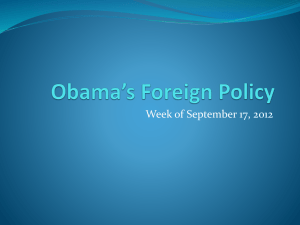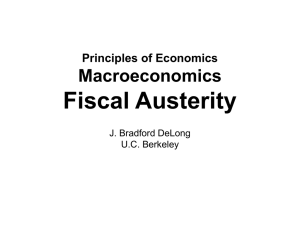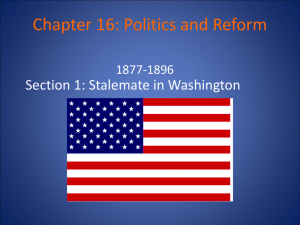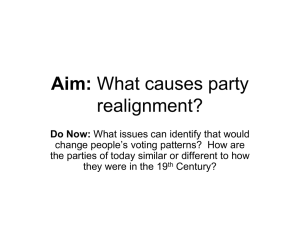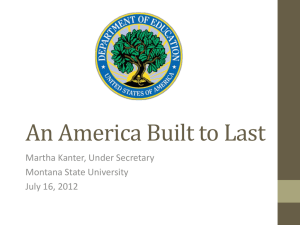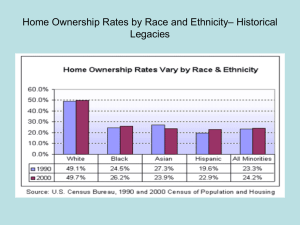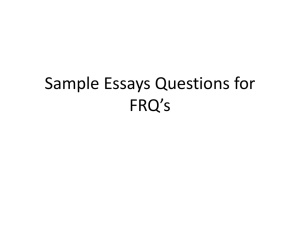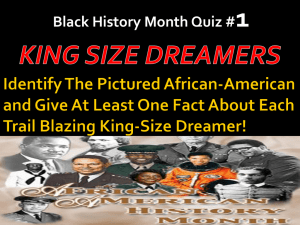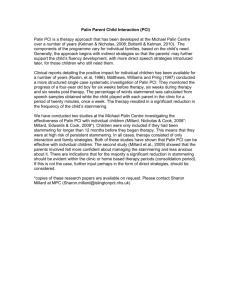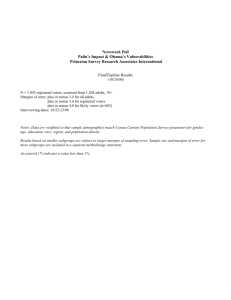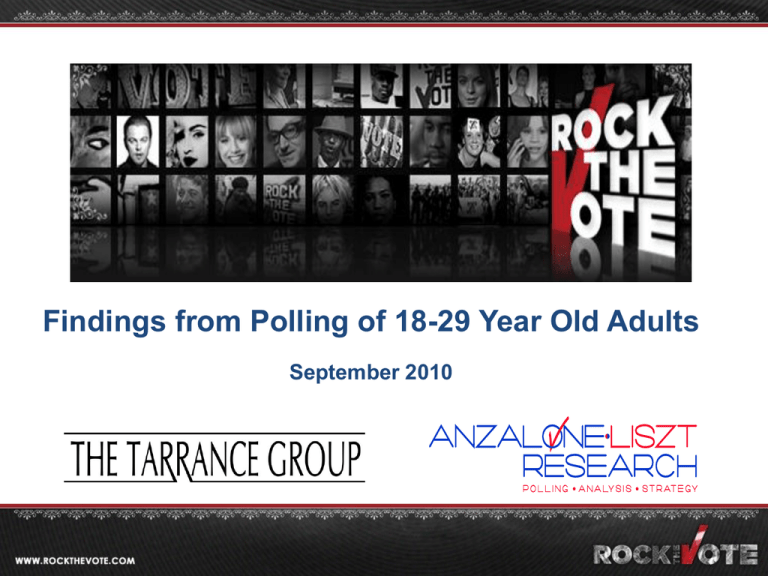
Findings from Polling of 18-29 Year Old Adults
September 2010
METHODOLOGY
• The national survey was conducted August 24-30, 2010 and consisted
of 700 phone interviews (500 landline and 200 cell phone) and 300
online interviews, for a total sample of 1,000 interviews with 18-29 year
olds.
• The margin of error for the nationwide poll is 3.7%
• Five, 300 sample statewide polls were also conducted in Colorado,
Florida, North Carolina, Ohio and Pennsylvania between August 25September 6, 2010. These polls were conducted entirely online, with
the exception of 100 landline interviews conducted in Colorado.
KEY FINDINGS
•
•
•
•
•
•
•
•
Young adults are paying attention to the upcoming election (57%), and are closely
attuned to pocket book issues like the economy, healthcare and college affordability.
Despite deep concerns about the influence of corporate and special interests on our
political system, they still plan to turn out in November, with 50% indicating that they are
very likely to vote.
A concern for both parties is that a plurality of this age group (36%) says that it doesn’t
matter to them which party is in control of Congress.
The issues this group is most focused on include unemployment, the cost and quality of
education, the national debt and reducing our dependence on foreign oil.
This voting bloc remains optimistic about their ability to bring change, as 83% say that
their generation has the power to change the country, but they have soured on politics
over the past two years, with 59% saying that they feel more cynical about the political
process than they did in 2008.
President Obama (56% favorable) and the Democratic Party (46%) still earn the highest
favorability ratings, with the Republican Party (36%), Sarah Palin (28%) and the Tea
Party (25%) trailing further behind.
President Obama is still an asset with this group, as 50% say they are more likely to
support a candidate that he endorses, while only 26% say the same about Sarah Palin
(64% less likely) or the Tea Party (54% less likely).
These young adults are also much more likely to support a candidate for U.S. Congress
that supports investing in new technology to create jobs, seeks to reduce our
dependence on foreign oil and who will provide leadership on key social issues like
immigration, marriage rights and sexual health education.
LIKELIHOOD OF VOTING
Compared to 2006, young voters are paying slightly less attention to the
upcoming midterm elections, but still, a firm majority of 58% indicates that
they are paying attention to the current campaign season.
Attention to November Elections: 2010 vs. 2006
2006
2010
Half of these adults say that they are very likely to vote this November, and when you add the somewhat
likely, a full 77% are likely to vote. Among, those who voted in 2008, nearly two-thirds (64%) of indicate
that they are very likely to vote again this cycle, with 90% saying they are likely to vote overall.
Republicans appear to be more energized, as 73% of McCain voters (compared to 62% of Obama
voters) and 60% of Republicans (compared to 51% of Democrats) indicate that they are very likely to
vote. Enthusiasm is lower among Independents, as just 38% indicate that they are very likely to go to the
polls on election day.
Likelihood of Voting: % Very Likely by Party and 2008 Vote
100
80
60
50
60
51
73
64
62
38
40
20
0
Overall
Dem
Ind
Rep
All 2008
voters
Obama
voters
% Very likely to vote in November
McCain
voters
Though nearly 60% say that they are more cynical about politics than they were two years ago and over threequarters (76%) say big corporations have too much power, young adults are still optimistic about the country and
their ability to bring change. More than four in five (83%) still believe that young people have the power to
change things in this country, nearly as high as the 89% who held that belief two years ago. Likewise, less than
half agree that they are less hopeful about the country’s future than they were two years ago. They are also
optimistic about their own future, with 73% believing that they will be better off financially than their parents.
Views on Politics and the Future
% Agree
As a group, young people have the
power to change things in this
country
83
Big corporations have too much
power in this country
76
Eventually, I expect to be better
off financially than my parents are
73
I am more cynical about politics
than I was two years ago
59
Politicians don't talk about the
issues that are important to me
47
I am less hopeful about the
country's future than I was two
years ago
47
0
7
20
40
60
80
100
ISSUES AND CONCERNS
A plurality of adults under 30 believe that the country is headed in the wrong direction
(49% wrong / 40% right), but they are not quite as pessimistic as older Americans.
Much of this is due to the larger share of minorities among 18-29 year olds, as they
are more upbeat about the country’s current path, while younger whites believe it is
headed in the wrong direction by a 2:1 margin (60% wrong / 30% right).
Country Direction: Overall and by Race
Right Direction
100
Wrong Direction
80
60
40
40
60
49
63
51
30
38
23
20
0
Net
9
Overall
White
African American
Hispanic
-9
-30
+40
+13
When we asked these young adults to choose the most important two issues from a list of twelve
ranging from healthcare to race relations to energy policy, the economy and jobs clearly emerged as the
dominant issue across every demographic group, with over half of 18-29 year olds overall identifying it
as one of their top two issues. The second most frequently cited issue – education and the cost of
college – finished well behind, with 29% naming it as one of their top two issues, followed by the deficit
and spending and healthcare.
Most Important Issue for Politicians to Address
54
34
Jobs and the economy
29
15
Education and the cost of college
23
12
The deficit and spending
23
9
Healthcare
14
7
Immigration
Afghanistan
4
Social issues / Gay rights /
Abortion rights
5
Environment and global warming
5
0
Most important issue
11
2nd most important issue
11
10
20
40
60
When asked about concerns at the national level, the nation’s unemployment rate was the dominant issue, with
nearly three-quarters of young adults very concerned (74%). The Bureau of Labor Statistics indicates young
people ages 16 to 24 have twice the unemployment rate as the rest of the country, and their anxiety is clearly
showing here. Falling closely behind was fears over the national debt, which two-thirds cited as a serious
concern (66%). Corporate influence in our political system and the country’s dependence on foreign oil were
also major worries, with half very concerned. Failing to take action against global warming, illegal immigration,
racism and terrorism were also sources of anxiety, but generated less intensity.
National Concerns
96
74
The level of unemployment in the country
93
66
The national debt
The influence of corporations and special interests in our political system
50
86
America's dependence on foreign oil
49
86
Too many illegal immigrants in the country
40
The United States suffering another major terrorist attack
38
Failing to take action on global warming or climate change
36
The amount of racism in the country
35
0
Very concerned
11
20
65
77
69
70
40
Somewhat concerned
60
80
100
When digging in to economic concerns, they are optimistic about their long term financial success but the
tough economy has made 18-29 year olds anxious about their ability to find a job that will allow them to live
comfortably, save for a home or retirement, pay off their student loans or that will allow them to enjoy work. At
least half of these young adults are very concerned about these prospects, with at least 70% expressing
some concern over them. Losing their job or not having enough to make major purchases also concern a
strong majority, though are not as intense as the others.
Personal Economic Concerns
Finding a job that pays enough
for me to be comfortable
55
Not having enough money to
save for a home or for
retirement
54
Not having enough money to
pay for school or student loans
51
Finding a job that I enjoy
50
80
70
70
58
37
Losing my job
Not having enough money to
buy a car, a computer or make
other major purchases
64
33
Having to move back home with
my parents
Very concerned
42
23
0
12
77
20
40
Somewhat concerned
60
80
100
When posed with four options of what the current focus of our economic policy should be,
investing in job creation and reducing the debt emerged as bigger priorities than making education
more affordable or cutting taxes. Among whites, job creation and the national debt were
particularly dominant, while minorities preferred job creation first and foremost, while giving equal
weight to the debt and making education and job training more affordable.
Most Important Aspect of Economic Policy to Address
Investing in job
creation
32
Reducing the national
debt
30
Making job training
and post-high school
education more
affordable
23
13
Cutting taxes
0
13
10
20
30
40
50
Despite their considerable concern over being able to pay for school and their student loans, young adults say
that when it comes to education policy, our biggest priority should be improving the quality of education in
elementary and high schools. This was particularly true among whites and those not currently in college, while
those in college and minorities were more likely to focus on college affordability. Closing the achievement gap
between the races finished below the other three options not only overall, but among African Americans and
Hispanics as well.
Most Important Aspect of Education Policy to Address
Improving the quality of
education in elementary and
high schools
44
Making college more
affordable
38
Expanding access to preschool and early childhood
education
9
Closing the achievement gap
between races
7
0
14
20
40
60
When it comes to what the focus of our energy policy should be, investing in new technologies to create
jobs and reducing our dependence on foreign oil were clearly preferred to focusing on combating
climate change, both overall and across demographic groups. Reducing our dependence on foreign oil
was most popular among whites, while African Americans and minorities were more likely to focus on
new investments to create jobs.
Most Important Aspect of Energy Policy to Address
Investing in new
technologies to create
jobs
43
Reducing our dependence
on foreign oil
40
Reducing our carbon
emissions to help fight
climate change
15
0
15
20
40
60
A strong majority of these young adults support legalizing gay marriage (55%). Hispanics
are just as supportive of legalization as whites, but a narrow majority of African Americans
are opposed. Democrats and Independents are also very supportive, though Republicans
are against legalization by a more than 2:1 margin.
Support for Legalizing Gay Marriage: Overall and by Race
Support
Oppose
100
80
56
55
60
39
38
40
51
43
56
37
20
0
Net
16
Overall
White
African American
+16
+18
-8
Hispanic
+19
When 18-29 year olds are asked to choose whether they believe teaching about
safe-sex and birth control or abstinence-only in schools is the best approach to
reducing teen pregnancy, they side resoundingly with safe-sex and birth control
(74% to 21%). This position spans ideologies, with even 58% of conservatives
siding with safe-sex and birth control.
Best Approach to Reducing Teen Pregnancy: Teaching Safe Sex vs. Abstinence Only
91
100
78
74
80
58
60
36
40
21
19
20
8
0
Overall
Liberal
Safe sex and birth control
17
Moderate
Abstinence only
Conservative
VIEWS OF POLITICAL PARTIES
AND FIGURES
Democrats now hold a 9-point advantage on party identification (35% to 26%), which
is down from the 18-point edge they held over Republicans on party ID (41% to
23%) in 2008. Most of this decline is due to whites moving towards Republicans.
Whites now identify with Republicans by a 9-point margin (34% to 25%), while
younger African Americans and Hispanics are still solidly Democratic.
Party Identification: Overall and by Race
80
Democrat
Independent
Republican
70
60
43
40
35
29
26
25
30
28
18
15
20
0
34
5
Overall
White
African American
Hispanic
Young adults still rate the Democratic party more favorably (46% to 41% unfavorable)
than the Republican party (36% favorable to 50% unfavorable), though the
Democrats’ current advantage represents a steep decline from the previous midterm
elections in 2006 (65%). The Republicans’ favorability meanwhile has been virtually
unchanged.
Shift in Party Favorability Since 2006
The Democratic Party
Favorable
The Republican Party
Unfavorable
100
80
60
65
50
46
41
38
36
40
48
25
20
0
Net
2010
+5
2006
2010
+40
-14
2006
-10
When asked whether they would prefer Democrats to keep control of Congress or for
Republicans to assume the reigns, a plurality of 18-29 year olds say that they don’t
really care. While those who identify with a party clearly express a preference, nearly
two-thirds of Independents say they are indifferent to which party is in control.
Preferred Control of Congress: Overall and by Party
80
73
70
63
60
40
34
28
36
28
24
16
20
15
2
1
0
Overall
Dem
Democrats retain control
Ind
Republicans take control
Rep
Doesn't matter to me
Democrats fared a little better in separate polling conducted in five states, with solid
pluralities preferring that they maintained control in four out of the five states. Still,
in no state did a majority prefer the Democrats to retain control, and in Colorado,
young adults were evenly split.
Preferred Control of Congress: By State
80
60
44
40
33 33 33
27 29
38
43
31 31
42
29 28
31 27
20
0
Colorado
Florida
Democrats retain control
North Carolina
Republicans take control
Ohio
Pennsylvania
Doesn't matter to me
Despite all its attention in the press, over a third of young adults (37%) are not
familiar enough with the Tea Party to rate it. Those that do rate it do so negatively
by an 11-point margin (37% to 26%), with both whites and Independents viewing it
unfavorably.
Tea Party Favorability
Fav
Unfav
Can't Rate
80
60
40
37
26
43
37
30
35
36
35
22
20
0
Net
Overall
-11
Whites
-5
Independents
-13
Views of President Obama and Sarah Palin have both significantly eroded since September of 2008.
However, Obama still earns strong ratings with these young adults rating him favorably by an 18-point
margin (56% to 38%). Palin, meanwhile, is now viewed negatively by a more than 2:1 margin (28% to
59%). Interestingly, Millenials do not seem to be nearly as critical of Congress as older Americans, as a
plurality rates it positively (43% to 39%), with views basically unchanged since September 2008.
Shift in Favorability Since 2008
Obama
The United States Congress
Palin
100
Favorable
Unfavorable
80
60
69
59
56
38
40
37
27
40
43
39
45
35
28
20
0
Net
2010
2008
+18
+42
2010
-31
2008
2010
2008
-3
+4
+10
After over 18 months in office, 18-29 year olds have mixed feelings on President
Obama’s performance in office. A plurality of 37% say they are disappointed in what
he has done, but nearly as many (34%) say that they have not yet decided. Those
who voted for him give him much more favorable views, but even among this audience,
less than half are happy with what he has accomplished (49% pleased).
Rating Obama’s First Two Years in Office
Pleased about what he's been able to accomplish
80
Disappointed in what he has done
Not yet sure
49
60
37
40
27
14
20
0
Net
36
34
Overall
-10
2008 Obama voter
+35
In three of the five states that we polled in, young adults’ ratings of President Obama’s job
performance track closely with his ratings nationally. But two states emerge as exceptions:
Colorado and Florida. Obama performs relatively well in the latter, with those under 30 in the
state satisfied with what he’s done by an 8-point margin (42% pleased to 34% disappointed). It
appears that the President may have his work cut out for him among younger adults in Colorado
however, as they say they are disappointed in him by a 19-point margin (27% to 46%
disappointed).
Rating Obama’s First Two Years in Office
Pleased about what he's been able to accomplish
80
Disappointed in what he has done
Not yet sure
60
46
40
42
42
34
27
27
24
30
39
28
27
40
34
34
26
20
0
Net
Colorado
Florida
North Carolina
-19
+8
-12
Ohio
-12
Pennsylvania
-6
MOBILIZATION
In terms of endorsements, President Obama will clearly be more of an asset with young voters this fall than
Sarah Palin or the Tea Party. While half of 18-29 year olds say they are more likely to support a candidate
supported by the President, just 26% say the same about Palin or the Tea Party. In fact, 64% say a Palin
endorsement would make them less likely to support a candidate, and a solid majority (54%) feels the same
about the Tea Party. Among Independents none of the three hold much sway, though Obama is viewed much
more favorably than Palin or the Tea Party.
Impact of Endorsement by Obama, Palin or Tea Party: Overall and Independents
Independents
Overall
100
More likely
Less likely
80
60
66
64
54
50
42
40
39
26
26
Net
23
19
20
0
50
46
Obama
+8
Palin
Tea Party
-38
-28
Obama
-7
Palin
-47
Tea Party
-27
The most popular of the sixteen policy proposals we tested involved investing in renewable energy to reduce
our dependence on foreign oil and increasing funding to make college more affordable, with 58% saying they
would be much more likely to support a candidate who took those positions. An all-of-the-above approach to
energy was the third best testing proposal, but was not quite as popular as focusing solely on renewables.
Interestingly, expanding safe sex education was the next best received, followed closely by withdrawing from
Afghanistan. These five proposals were the most popular among both those most and least likely to vote.
Policy Proposals: Top Tier
Supports increasing investment in renewable energy sources to
help reduce our dependence on foreign oil
58
Supports increasing government grants to help make college and
post-graduate education more affordable
58
Supports increasing investment in renewable energy sources and
expanding offshore oil exploration and the use of nuclear energy
to help reduce our dependence on foreign oil
86
81
49
77
42
Supports expanding safe-sex education in schools
Supports starting the process of pulling all U.S. troops out of
Afghanistan
70
40
0
Much more likely
29
89
20
40
Somewhat more likely
60
80
100
In addition to the most popular proposals, two-thirds were more likely to support a candidate for Congress that
called for ending the Bush tax cuts for the wealthy, supported increasing foreign aid to combat deadly diseases
and limiting carbon emissions through a carbon tax or cap. Unlike older Americans, a strong majority (57%) of
young adults were also more likely to support a candidate that voted for the new healthcare law, with a plurality
also more likely to support someone who advocated for providing illegal immigrants with a path to citizenship.
Other Policy Proposals
Supports ending the Bush tax cuts for those earning over two
hundred fifty thousand a year to help reduce the deficit
Supports increasing aid to foreign countries to help combat HIV
and other deadly diseases
67
32
Supports a cap or tax on carbon emissions to help combat
global warming
28
Voted for the new healthcare reform law
28
65
57
50
21
Supports providing illegal immigrants with a path to citizenship
0
Much more likely
30
67
34
20
40
Somewhat more likely
60
80
100

